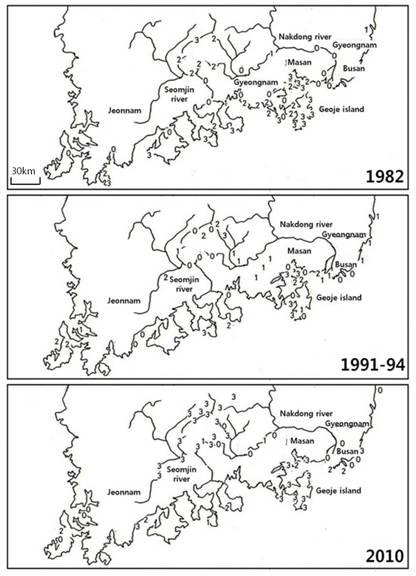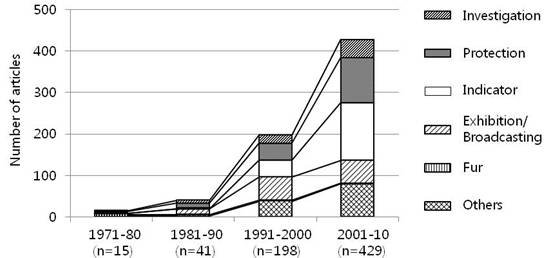IUCN/SSC Otter Specialist Group Bulletin

|
©IUCN/SCC Otter Specialist Group Citation: Kim, H., Ando, M., Han, S., Sasaki, H. and Ogawa, H. (2011) Recovery of the Eurasian Otter Lutra lutra in Korea and the Change in Public Attitude. Proceedings of XIth International Otter Colloquium, IUCN Otter Spec. Group Bull. 28B: 85 - 90 Recovery of the Eurasian Otter Lutra lutra in Korea and the Change in Public Attitude Hyeonjin Kim1, Motokazu Ando1, Sungyong Han2, Hiroshi Sasaki3 and Hiroshi Ogawa1
1Laboratory of Wild Animals, Tokyo University of Agriculture, Atsugi 243-0034, Japan Email: motokazu.ando@nifty.com |
| Hyeonjin Kim, Motokazu Ando and Sungyong Han; other author photo not available |
| (Received 27th March 2012, accepted 17th April 2012) |
|
Abstract:Since the 1970s, South Korea has attained unparalleled and rapid economic growth. To analyze the impact of subsequent habitat deterioration on the Eurasian otter (Lutra lutra), the distribution of otter spraints along sea coasts and major rivers was surveyed in 1982, 1991–94, and 2010. On the basis of the density of spraints and questionnaire-based surveys given to local residents, scores ranging from 0 (no information and no spraints) to 3 (>1 spraint/500 m) were assigned to each study area. Along rivers, the average scores decreased from 1982 to 1991–94, but recovered in 2010. In coastal areas, the scores were rather constant from 1982 to 2010. During 1971–2010, the number of otter-related articles increased almost in proportion to the rise in the GDP. During this period, the content of otter-related articles shifted from its use as a fur animal to that of an animal symbolic of healthy environments. |
| Française | Español |
INTRODUCTION
For the past several decades, South Korea (hereafter Korea) has attained unparalleled and rapid economic growth (Table 1). Advancement of river and coastal improvement works, large-scale reclamations, enlargements of industrial areas, and an increase in road traffic adjacent to rivers and coastlines have drastically modified otter habitats. During this period, the environmental consciousness of Korean people has also changed. In late 1980s, the Korean mass media repeatedly reported on problems caused by pollution. The Environment Ministry was established in 1990, and improvement in river water quality was among their most important tasks then.
| Table 1: Growth in the GDP and river improvement rate in Korea | ||||
| 1980 | 1990 | 2000 | 2010 | |
| GDP (Billion US$) | 39 | 191 | 603 | 1,172 |
| River improvement rate (%)* | 52 | 55 | 71 | 80 |
| *Ministry of Land, Transport and Maritime Affairs (2010). | ||||
Although the Eurasian otter (Lutra lutra) has been designated as a National Natural Monument since 1982, there has been no long-term monitoring of its status. The study of otter status in the 1980s is limited to Ando et al. (1985), who studied the southern coast. In the latter half of the 1990s, several otter status reports at specific geographic regions started to appear (Ministry of Environment, 1997 and 1998). Nationwide change in otter status during 1997–2009 is briefly reported in a general wildlife survey report (National Institute of Biological Resources, 2007). However, those studies are insufficient to understand the long-term otter population trends in Korea. This study 1) investigates general trends of the otter population during high economic growth, and 2) provides an overview of changes in people’s interests concerning otters, as seen in newspaper articles.
METHODS
Long-term change in otter density
In line with the survey method of Ando et al. (1985), a density survey of otter spraints was conducted and local residents were provided with a questionnaire at coastal and major river sites located in the southern part of Korea in 1982 (47 survey sites, each more than 500 m long), 1991–94 (39 sites), and 2010 (48 sites). The sites were selected along the southern coastal area of Korea extending 320 km east to west. The minimum distance between neighboring sites was 1 km. Sites in three surveys were not identical as some sites were lost to land reclamation and other development activities. In those cases, alternative nearby sites were chosen. The questionnaire was given to at least three local people or park administrators who lived within the study sites. When these people were unavailable, residents in the vicinity were questioned. The questionnaire items included “Do you know of an animal called the otter?,” “Have you ever seen an otter?,” and “Have you heard any information indicating the presence of an otter in the vicinity?.” In Korea, it is improbable that the otter is misidentified as another species, except for the alien nutria, which has settled in freshwater bodies elsewhere. Scores were given to each site according to the following criteria: 0, negative information from residents and spraints not found; 1, positive information from residents, but spraints not found; 2, <1 spraint/500 m; 3, >1 spraint/500 m. Scores in 1982 were cited from Ando et al. (1985). The mean scores for coastal and river sites were calculated for each period.
Trends of newspaper articles and increase in awareness activities
Otter-related newspaper articles during 1970–2010 were retrieved from the databases of three national papers (Dong-a Ilbo, Kyunghyang Shinmun, and Maeil Business Newspaper) using the keyword “sudal” (meaning “otter”) in both Korean and Chinese characters. Other awareness-related activities in Korea encountered in the field, in publications, and on the Internet were also randomly collected.
RESULTS
Long-term fluctuation in otter density
In 1982, when road and river improvement works were still not intensive, the average otter density scores were 1.7 at the coast and 1.3 in rivers (Table 2 and Fig. 1; Ando et al., 1985). During 1991–1994, average scores were 1.4 at coasts and 1.0 at rivers, showing a decreasing tendency in both habitat types. Spraints became less frequent at mid-stream and up-stream areas of large rivers, as well as along industrialized coasts.
| Table 2: Change in average otter density scores along rivers and coasts. | |||
| 1982 | 1991-94 | 2010 | |
| Rivers | 1.3 (n = 11) | 1.0 (n =15) | 2.2 (n = 24) |
| Coasts | 1.7 (n = 36) | 1.4 (n = 24) | 1.6 (n = 24) |
 |
| Figure 1: Change in otter density between 1982 and 2010. Click for larger version |
In 2010, the scores were 1.6 at coasts and 2.2 at rivers. While scores in coastal areas were rather constant, spraints were found at places such as paved coastal roads with heavy population and car traffic. Spraints were even found among the highly populated areas of Busan city (population of 4 million). Although those coasts had been largely modified by reclamation and road/bridge construction during the 1980s–1990s, spraints were found even at places where they had never been recognized. Scores at rivers clearly indicated a recovering tendency. They were also found at rivers flowing through Deagu city (population of 1.5 million).
Trends of newspaper articles
From 1971 to 2010, the number of otter-related articles increased almost in proportion to the rise in the GDP (Fig. 2). From the 1980s to 2000s, for example, the number of articles increased about 10 times, while the GDP rose by about eight times. During this period, the content of otter–related articles shifted from the otter as a fur animal to that of an animal symbolic of a healthy environment. In the 1970s, the number of articles was limited, and these articles dealt with the quality of otter pelts and poaching issues. In the 1980s, fur-related articles almost disappeared, most likely because of the otter’s designation as a National Natural Monument in Korea in 1982. During this decade, articles on the conservation needs of the otter and other wild animals appeared for the first time, and television programs emphasizing otter conservation were aired. In the 1990s, articles began introducing the otter as an animal indicative of healthy and clean environments. Environmental movements also utilized the otter as a symbolic animal to oppose development projects. Some articles focused on research results indicating a decrease in otter population. In the 2000s, article trends observed in the 1990s intensified. In the late 2000s, articles introducing collaborative otter conservation programs between governments and businesses appeared. In addition, articles on otter roadkills also appeared in the 2000s.
 |
| Figure 2: Change in otter density between 1982 and 2010. Click for larger version |
Increase in awareness activities and involvement of the private sector
In support of otter conservation, the Korean national government established several protected areas; for example, reservoirs where otter spraints were often found have been designated as protected areas. At the Jingyang Reservoir, water level control has been restricted for otter conservation purposes and artificial islets proposed for otter refuge. Awareness activities have also increased. The Korean Water Resources Authority constructed an “otter ecological park” near the Gucheon Reservoir. Signboards appealing for otter protection by reducing car speed to prevent otter road deaths have been seen elsewhere. Of the 20 river sites that were visited in 2010, seven such signboards were identified at four sites. The private sector has also cooperated in otter conservation. For example, an oil company hosted otter conservation events to encourage the participation of younger generations in conservation activities. As a contract project between the Cultural Heritage Administration and a private IT company, they introduced a new car navigation system such that an otter warning mark appeared on the display at sections where otter roadkills were frequent.
DISCUSSION
The otter population showed decreasing tendency in the 1980s and 1990s. However, after 2000, despite high economic growth and habitat degradations in Korea, the otter seems to be recovering by adapting to artificially modified environments. The Environment Ministry of Korea conducted a wildlife line census annually from 1997 to 2007 at 405 areas covering 12,210 ha (National Institute of Biological Resources, 2007). According to the result, no otter was recorded during 1997–1998. During 1999–2007, however, 7–14 otters have been steadily recorded. This indicates the threatened status of the otter in 1990s.
The BOD of the Nakdong River in Busan was 3.6 mg/l in 1981, 4.6 mg/l in 1994, and 2.4 mg/l in 2010 (Nomura et al., 1993; Ministry of Environment, 1995–2011), indicating steady recovery of water quality. The recovery of water quality was largely due to the intensive governmental efforts after the late 1990s (Oh, 2002). The fact that otter spraints at the Nakdong River were recorded for the first time in 2010 seems to be a reflection of water quality improvement.
Mass media’s interest in the otter was less intensive during 1970s and 1980s. However, it increased rapidly in the 1990s and 2000s. Note that the increase was proportionate to that in the GDP. This perhaps indicates that people became more conservation-conscious as they became wealthier. In the 1990s, not only governmental bodies but also the private sector started participating in conservation activities. Presently, the otter has become an animal symbolic of improved water quality and healthy environments in Korea.
REFERENCES
Ando, M., Son, S. W., S. Shiraishi. (1985). The common otter Lutra lutra in Southern Korea. Science bulletin of the Faculty of Agriculture, Kyushu University. 40: 1-5. [in Japanese].
Ministry of Environment. (1995-2011). Environmental Statistics Yearbook: 1995-2011. Ministry of Environment. [in Korean].
Ministry of Environment. (1997). A Study on Inhabitation of Otter, and Restoration of Habitat Environment in Seomjin River. Ministry of Environment, 119 pp. [in Korean].
Ministry of Environment. (1998). Research on inhabitation of Otter in Geoje Island. Ministry of Environment, 65 pp. [in Korean].
Ministry of Land, Transport and Maritime Affairs. (2010). List of rivers in Korea. Ministry of Land, Transport and Maritime Affairs, pp. 21-22. [in Korean].
National Institute of Biological Resources. (2007). Ecological Characteristics of Wildlife Populations. National Institute of Biological Resources. pp. 66-67. [in Korean].
Nomura, Y., Sakumoto, N. (1993). Environmental law of Developing Countries: East Asia. Institute of Developing Economies, pp. 126-128 [in Japanese].
Oh, J.G. (2002). Establishment of Comprehensive Water Quality Improvement Measures on the 4 Major Rivers, Enact and Enforce of Special Law. Environmental Preservation. 24: 6-13. [in Korean].
Résumé : Retour de la Loutre d’Europe Lutra lutra en Coree du Sud et Changement de Perception de la Part du Public
Depuis les années 1970, la Corée du Sud connait une croissance économique rapide et inégalée. Pour analyser l'impact de la détérioration de l'habitat sur la Loutre (Lutra lutra), la répartition des épreintes le long des côtes et des fleuves a été étudiée en 1982, 1991-94 et 2010. Sur la base de la densité des épreintes et les résultats des enquêtes menées auprès des résidents locaux, des notes allant de 0 (aucune information et aucune épreinte) à 3 (plus d’une 1 épreinte sur 500 m) ont été affectées à chaque zone d'étude. Le long des rivières, la note moyenne a diminué entre 1982 à 1991-94, mais a augmenté en 2010. Dans les zones côtières, les résultats sont plutôt constants entre 1982 et 2010. Au cours de la période 1971-2010, le nombre d'articles liés à la Loutre a augmenté dans la même proportion que la hausse du PIB. Durant cette période, le contenu de ces articles est passé de l’utilisation de la Loutre comme animal à fourrure à celle d'un animal symbolique d'environnements sains.
Revenez au dessus
Resumen: Recuperación de Lutra lutra en Corea del Sur y el Cambio en Público Actitud
Desde la década del 70, Corea del Sur ha tenido un rápido crecimiento económico, sin precedentes. Para analizar el impacto del deterioro de hábitats consiguiente, sobre la nutria Eurasiática (Lutra lutra), relevamos la distribución de fecas de nutria a lo largo de las costas marinas y grandes ríos, en 1982, 1991-94, y 2010. Sobre la base de la densidad de fecas y de encuestas basadas en cuestionarios a residentes locales, le asignamos puntajes a cada área de estudio -desde 0 (sin información ni fecas) hasta 3 (>1 feca/500 m). A lo largo de los ríos, los puntajes promedio disminuyeron de 1982 a 1991-94, pero se recuperaron en 2010. En las áreas costero-marinas, los puntajes fueron bastante constantes entre 1982 y 2010. Durante 1971-2010, el número de artículos relacionados con la nutria aumentó casi en proporción al aumento en el PBI. Durante este período, el contenido de los artículos relacionados con nutrias se fue desplazando, desde el uso de las mismas como animal para piel, hacia lo relacionado con un animal simbólico de ambientes saludables.
Vuelva a la tapa


